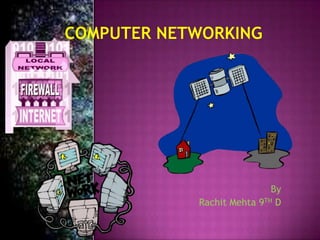
Computer networking
- 1. By Rachit Mehta 9TH D
- 2. •In September 1940, George Stibitz used a Teletype machine to send instructions for a problem set from his Model at Dartmouth College to his Complex Numbers Calculator in New York and received results back by the same means. Linking output systems like teletypewriters to computers was an interest at the Advanced Research Projects Agency (ARPA) when, in 1962, J.C.R. Licklider was hired and developed a working group he called the "Intergalactic Network", a precursor to the ARPANET •Early networks of communicating computers included the military radar system Semi-Automatic Ground Environment(SAGE), started in the late 1950s •The commercial airline reservation system semi-automatic business research environment(SABRE) which went online with two connected mainframes in 1960. •In 1964, researchers at Dartmouth developed the Dartmouth Time Sharing System for distributed users of large computer systems. The same year, at Massachusetts Institute of Technology, a research group supported by General Electric and Bell Labs used a computer to route and manage telephone connections. •Throughout the 1960s Leonard Kleinrock, Paul Baran and Donald Davies independently conceptualized and developed network systems which used packets that could be used in a network between computer systems. •1965 Thomas Merrill and Lawrence G. Roberts created the first wide area network . •The first widely used telephone switch that used true computer control was introduced by Western Electric in 1965. •In 1969 the University of California at Los Angeles, the Stanford Research Institute, University of California at Santa Barbara, and the University of Utah were connected as the beginning of the ARPANET network using 50 Kbit/s circuits. •Commercial services using X.25 were deployed in 1972, and later used as an underlying infrastructure for expanding TCP/IP networks.
- 3. Computer Networks Computer network connects two or more autonomous computers. The computers can be geographically located anywhere.
- 4. Computer Networks Resource Sharing Hardware (computing resources, disks, printers) Software (application software) Information Sharing Easy accessibility from anywhere (files, databases) Search Capability (WWW) Communication Email Message broadcast Remote computing Distributed processing (GRID Computing)
- 5. CATEGORIES OF NETWORKS
- 7. The way computers are connected The network topology defines the way in which computers, printers, and other devices are connected. A network topology describes the layout of the wire and devices as well as the paths used by data transmissions. Please note= This topic is not in course but is necessary to know…
- 8. Computer Networks Network in small geographical Area (Room, Building or a Campus) is called LAN (Local Area Network) Network in a City is call MAN (Metropolitan Area Network) Network spread geographically (Country or across Globe) is called WAN (Wide Area Network)
- 9. Allow resource sharing between computers. Computers Peripheral devices Transmission medium (e.g. cable) 3 types of topology Bus topology Star topology Ring topology
- 10. LANs Figure 6-4 Hub – a device that facilitates connection LAN acts logically like a bus. Star – the dominant topology today.
- 11. MAN
- 12. Usesservices provided by a network service provider. (Tel. Company) Individual users’ computers Organizations’ LANs Many Tel. Company provide a popular MAN service called SMDS (Switched Multimegabit Data Services) Prior to SMDS's arrival in 1995, the only way to connect LANs was through a dedicated private line.
- 13. WAN
- 14. Theconnection of individual computers or LANs over a large area (country, world). Userusing a telephone line to connect to an ISP (Internet Service Provider) is using a WAN. Negotiates fee ISP Tel. company
- 16. WiFI: Short for ‘wireless fidelity’. A term for certain types of wireless local area networks (WLAN) that use specifications conforming to IEEE 802.11b. WiFi has gained acceptance in many environments as an alternative to a wired LAN. Many airports, hotels, and other services offer public access to WiFi networks so people can log onto the Internet and receive emails on the move. These locations are known as hotspots. LAN: A computer network that spans a relatively small area. Most LANs are confined to a single building or group of buildings. However, one LAN can be connected to other LANs over any distance via telephone lines and radio waves. There IS a difference between these two items. WiFi is a Wireless Network like a wireless home network or a hotspot at a local coffee shop or the airport or a WiFi cafe. A Wireless Card is an Adapter placed inside the computer or the Laptop which is needed to access the WiFi Network you wish to connect to.
- 17. •Communications satellites – The satellites use microwave radio as their telecommunications medium which are not deflected by the Earth's atmosphere. The satellites are stationed in space, typically 35,400 km (22,000 mi) (for geosynchronous satellites) above the equator. These Earth-orbiting systems are capable of receiving and relaying voice, data, and TV signals. • A global area network (GAN) is a network used for supporting mobile across an arbitrary number of wireless LANs, satellite coverage areas, etc. The key challenge in mobile communications is handing off the user communications from one local coverage area to the next. In IEEE Project 802, this involves a succession of terrestrial wireless LANs. • Terrestrial microwave – Terrestrial microwaves use Earth-based transmitter and receiver. The equipment looks similar to satellite dishes. Terrestrial microwaves use low-gigahertz range, which limits all communications to line-of-sight. Path between relay stations spaced approx, 48 km (30 mi) apart.
